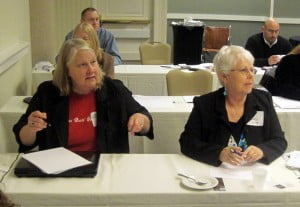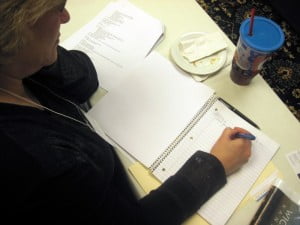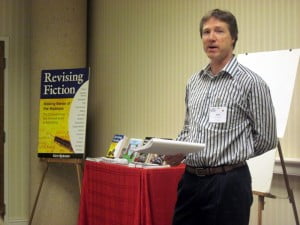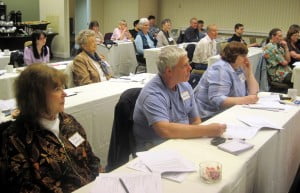We kept a live blog going during the KWA Scene Seminar with speaker Kirt Hickman. If you couldn’t make it, check out a sample of what you missed! — Erin Perry O’Donnell, Scene Seminar Coordinator
4:19 p.m.
Critiques–everyone needs them. Many of us fear them. How do you keep those comments about your life’s work–your baby!–in perspective? Kirt says:
- Remember that a critique is not personal. The reader is genuinely trying to improve the writing.
- You asked for, and perhaps paid for, their honest opinion. Don’t be upset when they give it to you!
- If they don’t point out problems, they’re not doing you any favors. It doesn’t matter what they are, though, because anything can be fixed.

3:30 p.m.
Are you one of those writers who hated English in high school? It’s your lucky day! We’re giving you permission to break some of the rules from senior composition — when it comes to writing dialogue.
- Sentence fragments. Use them. (See what I did there?). Kirt says anything you can do to compress dialogue will make it punchier and increase the tension.
- Use contractions. You do it when you talk, so don’t restrict your characters’ speech.
- No long, 50-cent words. Most people don’t use them when they talk.
On the other hand, don’t get so realistic with dialogue that you include every “uh” and “well.” Jump past the pleasantries too, and start the talking when it gets interesting. Think natural, not cinema verite.
3:12 p.m.
Have trouble showing your characters’ emotions rather than telling about them? Check out Creating Character Emotions by Ann Hood, with tips on 36 different emotions and how to infuse your story with them.

2:17 p.m.
Another dynamic definition for you: What is the difference between suspense and tension? Duration. Tension is momentary. Suspense makes the reader keep turning pages. Tension makes their heart race.
2:13 p.m.
How many times have you heard “Show, don’t tell”? How many times have you wondered what that really means? Here’s how Kirt says to think about it: You may state facts. But don’t draw conclusions for the reader. Ask yourself, how does my character know this? What is he experiencing or seeing that allows HIM to draw that conclusion?
11:01 a.m.
How to muzzle your internal editor?

Get up early. Skip the coffee. No, really. Kirt says, “Your editor needs the caffeine. Your muse does not. Your muse is up dreaming all night. You can get a good couple hours writing in before your editor even realizes you’re up.”
Write longhand on unlined paper. This will open up your right brain. Typing is a left-brained process, and that’s your editor.
Don’t stop to edit.
10:17 a.m.
Kirt’s giving us a great tour through the elements of plot, from starting points to dark moments and resolution. We’re using well-known movies to illustrate some of the points. Who knew the Donkey in Shrek fulfilled the mentor role? Or that your mentor and antagonist can be the same person in romances? (See: You’ve Got Mail.)
9:46 a.m.
Amateur pitfalls of character development:

- Make each character’s personality different, so they don’t all act and talk the same.
- Make your hero strong-willed. If a character does not believe enough in their goal to assert themselves to achieve it, your reader is not going to care enough to read about it.
- Don’t make your hero just an observer, watching everyone around them solve the problem.
- No cliché character traits: no dumb blondes or mad scientists. Do the opposite of what the reader expects.
- Don’t forget your secondary characters. No cardboard cutouts.

9:19 a.m.
Kirt on knowing your characters: You need to know a lot more about your characters than your reader ever will. The better you know your characters, the more real they are for you, and the more real for someone else. You should be able to talk about this character as if they were someone you actually know.
9:12 a.m.
Our speaker, Kirt Hickman, is going over the basics of self-editing. Two of the things we all know to watch out for are 1) show, don’t tell, and 2) use active voice, not passive voice. What I never considered is that these two things often occur together. When you’re editing your manuscript, you may notice them together but not if one occurs on its own. So, edit for one thing at a time. Focus on one element during one read, then look for the other on a second pass.

